Door handle
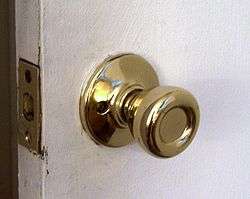
A door handle is an attached object or mechanism used to manually open or close a door.[1] In the United States, a door handle generally refers to any fixed or lever-operated door latch device. The term door knob or doorknob tends to refer to round operating mechanisms. Home-entry door handles are usually more sophisticated than bedroom door handles.
Description
The traditional door knob has a bolt or spindle running through it that sits just above a cylinder, to which the spindle is connected. Turning the knob pulls the cylinder in the direction of the turn. The end of the cylinder is the "latch bolt" (more simply known as the "latch"), which protrudes into a space carved out of the door frame, and which prevents the door from being opened if the knob is not turned. A spring or similar mechanism causes the latch to return to its protruding state whenever the knob is not being turned. escutcheon plates are the keyhole covers, usually circular, through which keys pass to enter the lock body. If the door handles have a square or rectangular plate on which the handle is mounted this is called the backplate. The backplate can be plain (for use with latches), pierced for keyholes (for use with locks), or pierced and fitted with turn knobs and releases (for use with bathroom locks). The plate on the front edge of the lock where the latch bolt protrudes is called the faceplate.[2]
Door handles can be and have been made out of a wide variety of materials. Just a few examples include brass, white porcelain, brown mineral, cut glass, wood, and Victorian bronze.[3]
Types
- The most common and basic type of doors handle is the Lever latch door handle on a backplate found in residential houses and commercial and public buildings. Doors fitted with this handle has a latch which is used to keep the door shut. The door handle features only a lever handle which operates this latch. When the handle is pushed down, the spindle rotates which “passes through the door and the tubular latch inside the door allowing the door to be opened”.[4] This type of door handle is normally found on doors leading into the living and dining rooms as they don’t require any type of locking. The lever latch handle is also easy to install and use and is available in a variety of styles and finishes.
- The Lever lock door handle on a backplate is another type of door handle which operates similarly to the lever latch door handle.[5] This type of handle on a backplate consists of a lever and just below it, a key hole cut. This allows a key to be inserted into the door to control a mortice sash lock. Just the like the lever latch, the door can be opened and shut by pushing the handle but can also be locked using a key. This locking mechanism is why this type of door handle is used for front and back doors of residential housing.
- The Lever Bathroom is typically used on bathroom doors as they can be locked easily from the inside and in and emergency can be opened from the outside. Locking the door from the inside is accomplished by turning the snib while a coin or something similar is required to open the lock from the outside. This lock is fitted with a mortice sash with the attached to a 5mm spindle which passes through the door.
- The Lever Privacy is similar to the Lever Bathroom in that it is locked by turning a snib on the inside and can be unlocked from the outside in emergencies. Unlike the Lever Bathroom, there is no mortice sash; the locking is achieved by jamming the lever in a closed position.[6]
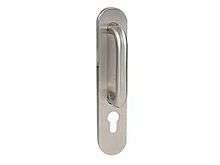
- Pull door handle or simply Pull handle are U-shaped and they are used especially in the kitchen but also for drawers. Usually made of stainless steel.
Usage
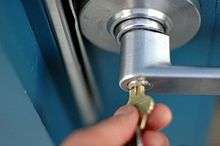
The location of the door handle along the horizontal axis on the door may vary between a few inches or centimeters away from the edge of the door to the exact center of the door, depending on local culture, decorative style or owner preference. The distance from the edge of the door to the center of the handle is called the backset.
The location of the door handle along the vertical axis on the door may vary between 34 to 48 inches (860 to 1,220 mm).[7]
Door knobs can be difficult for the young and elderly to operate. For this reason, door handles in most American commercial and industrial buildings and in many households are lever-operated, rather than a knob, as the lever does not require a tight grip. Levers are also beneficial on doors with narrow stile widths where the reduced backset leaves insufficient space to comfortably turn a door knob.
Most household door handles use a simple mechanism with a screw-style axle (called a spindle) that has at least one flat side, which is passed through the door jigger, leaving some length exposed on each side of the door to which the handles are attached. Some handles are attached on both sides by screwing or sliding them directly onto the spindle, and then securing one or more retaining screws (set screws) through the knob perpendicular to the flat of the spindle. Handles that lose traction can frequently be repaired by replacing or adjusting the set screw, which prevents them from slipping on the spindle. Other types of handles, typically used in Europe, slide onto the spindle but are affixed only to the door itself without use of set screws.
Types of household handles:
- Entrance: These door handles are typically used on exterior doors, and include keyed cylinders.
- Privacy: Typically used on bedrooms and bathrooms; while they are lockable (unlockable with a generic tool), they do not have keyed cylinders.
- Passage: Also known as hall or closet, these do not lock and are used in hall or closet doors.
- Dummy: These types are used for ball catch doors or other applications where a mechanism is not needed, but a similar aesthetic effect is desired.
Cars
Car door handles may protrude from the vehicle's exterior surface or be streamlined into the vehicle's contour. In some automobiles, especially luxury vehicles, the door handles may feature a key-less entry pad utilizing either a numerical code or thumb scan.
Foldables
On a balcony whose door has an outside shutter, a special door handle is used on the outer side. The protruding part of such handle (usually ring-shaped) can be folded sideways, so that the shutter can be fully closed without being obstructed by the door handle.
Pocket doors
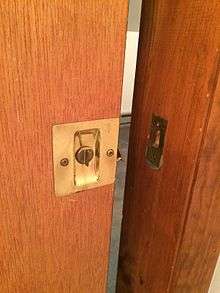
A pocket door handle is a recessed rectangular insert, typically with operating hardware called a door pull.[8]
Door handles can also be called "handle sets". In addition there are door handles that are flush-mount and require pressing rather than turning or gripping, and there are touch-free, electronic, and motion-sensor door handles.
Infection control
Of concern is the fact that door handles are instrumental in the spread of many infections.[9] However, some materials, e.g. brass, copper and silver, are slowly poisonous to many germs. The exact mechanism is not known, but is commonly thought to be via the oligodynamic effect, perhaps by some other electrostatic effect.[10] Brass and copper, for example, disinfect themselves of many door handle bacteria within eight hours.[11] Other materials such as glass, porcelain, stainless steel and aluminium do not have this effect. Self-disinfecting door handles are particularly important in hospitals, but useful in any building.
- Outside door handle of a 1998 Lincoln Town Car, featuring digital lock.
- Outside door handle of a 1996 Lancia Y, hidden on the B pillar.
 Inner door panel of a 1998 Lincoln Town Car, featuring a chromed door handle often associated with luxury cars.
Inner door panel of a 1998 Lincoln Town Car, featuring a chromed door handle often associated with luxury cars..jpg) Inner door handle of a 2010 Porsche 911 GT3 RS, consisting of a canvas strap for weight reduction.
Inner door handle of a 2010 Porsche 911 GT3 RS, consisting of a canvas strap for weight reduction.
Gallery
 Door latch at Madingley Hall, Cambridgeshire
Door latch at Madingley Hall, Cambridgeshire Ornate door handle on a Moravian Church.
Ornate door handle on a Moravian Church. A door handle in the center of a door in Paris
A door handle in the center of a door in Paris- Head shaped doorknob, Florence
 The doorknobs at Glen Eyrie castle in Colorado Springs
The doorknobs at Glen Eyrie castle in Colorado Springs Traditional door handles in Korea
Traditional door handles in Korea A Tulip Schlage doorknob
A Tulip Schlage doorknob "Crash bar" handle installed on a glass exterior door
"Crash bar" handle installed on a glass exterior door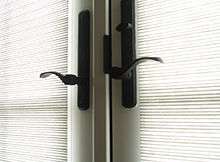 Lever-style door handle
Lever-style door handle- Commercial duty lever door handle
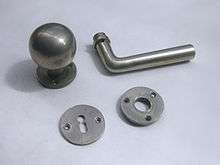 Door handles designed by Ferdinand Kramer, 1925
Door handles designed by Ferdinand Kramer, 1925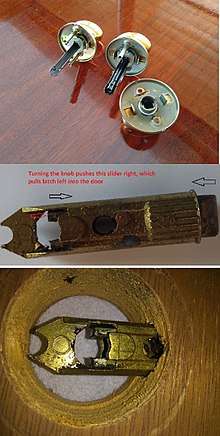 Knob has crescent-shaped bar which pulls back latchbolt when turned. Version on upper right has a lock; version on upper left does not. Kwikset uses this shape. Other companies have square or D-shaped bars.
Knob has crescent-shaped bar which pulls back latchbolt when turned. Version on upper right has a lock; version on upper left does not. Kwikset uses this shape. Other companies have square or D-shaped bars.
References
- ↑ "Doorknob". Dictionary.com. Archived from the original on 2008-04-27. Retrieved 2008-04-28.
- ↑ "Doors". nygate.com. Archived from the original on 2015-02-27. Retrieved 2015-02-28.
- ↑ "6 Classic Doorknobs for Old Houses". Archived from the original on 2015-09-24.
- ↑ Different Types of Door Handles Explained Archived 2016-11-17 at the Wayback Machine. retrieved November 2016
- ↑ Buying Door Handles – Things You Need To Know Archived 2016-11-16 at the Wayback Machine. retrieved November 2016
- ↑ Master of Unlocking: The Different Types of Door Handles Archived 2016-11-16 at the Wayback Machine. retrieved November 2016
- ↑ "Archived copy". Archived from the original on 2015-08-05. Retrieved 2015-08-08.
- ↑ "Repairing Balkiness or Binding of Pocket Doors". www.gsa.gov. Archived from the original on 2015-09-24.
- ↑ "Infectious diseases". MayoClinic.com. 2011-07-20. Archived from the original on 2009-04-30. Retrieved 2012-09-24.
- ↑ "Journal of Materials Science: Materials in Medicine, Volume 19, Number 9". SpringerLink. Retrieved 2012-09-24.
- ↑ "BrassversusStainless Steel". Members.vol.at. Archived from the original on 2012-02-16. Retrieved 2012-09-24.
External links
![]()